Garden Pyramid Ideas: Creative Ways to Elevate Your Outdoor Space
Looking to add some creativity to your garden? Garden pyramids might be just what you need to transform your outdoor space into a beautiful display. These unique structures offer a fun and efficient way to grow a variety of plants in a compact area.

Why might you love garden pyramids? They not only save space but also create eye-catching focal points that can enhance the overall look of your garden. Whether you’re growing strawberries, herbs, or flowers, there’s a garden pyramid idea that can suit your needs and style.
1) Tiered Vegetable Garden

A tiered vegetable garden is a great way to maximize your gardening space. You can grow a variety of vegetables even in a small area. The tiered design allows you to plant vegetables at different levels.
This makes it easier to tend to each plant. You don’t have to bend over as much, and the plants receive good sunlight.
Using tiered garden ideas can also make your garden look more interesting and beautiful.
2) Strawberry Pyramid Planter

A strawberry pyramid planter is a great way to grow lots of strawberries without using much space. You can place it in your garden, on a deck, or even on a patio.
These planters let you grow up to 60 strawberry plants in a small area. For example, a DIY pyramid planner can be 6 feet tall and provide over 60 feet of growing space.
To build your own, you can follow guides from sites like Bonnie Plants. Make sure to pick a sunny spot, as strawberries need plenty of sunlight to thrive.
3) Herb Spiral

An herb spiral is a great way to grow a variety of herbs in a small space. This garden pyramid is built in the shape of a spiral, taller in the middle and circling down to ground level.
You can use materials like stones or bricks to create the spiral. Each layer of the spiral provides different growing conditions, perfect for various herbs.
Herb spirals not only look beautiful but also help to maximize space and biodiversity. They are popular in permaculture design, offering a functional yet visually appealing garden feature.
4) Succulent Pyramid

Creating a succulent pyramid is a fun and eye-catching way to add greenery to your garden. You can use stacked cinderblocks or wooden pallets to build the structure. Each layer of your pyramid can hold different succulent varieties, providing a unique texture and color.
Succulents thrive in well-draining soil, so make sure you use a mix designed for these plants. A pyramid planter not only saves space but also makes a striking focal point in any garden. For ideas on building your own, check out these DIY pyramid planter plans.
5) Flowers and Ferns Pyramid

Creating a flowers and ferns pyramid is an easy way to add beauty and greenery to your garden. You can combine colorful flowers with lush ferns for a stunning visual effect.
Start with hardy ferns at the base. They thrive in shaded areas and add a rich green backdrop.
Add vibrant flowers like petunias or marigolds in the middle layers. These flowers bring pops of color to the design.
Top your pyramid with smaller, delicate flowers like violets. This creates a cascading effect and keeps your garden lively and fresh.
6) Wooden Crate Pyramid

A Wooden Crate Pyramid is a simple and charming way to grow plants. You can easily find wooden crates at your local hardware store or recycle old ones.
Stack the crates to form a pyramid shape. This structure is perfect for growing vegetables, herbs, and flowers.
This pyramid design is sturdy and offers plenty of space for your plants to thrive.
7) Cinder Block Pyramid Planter

A cinder block pyramid planter is a fun and sturdy project for your garden. This type of planter is built by stacking cinder blocks in a pyramid shape, which can create a striking focal point.
You can customize the size of your pyramid by adding more layers of cinder blocks. It’s a creative way to grow herbs, flowers, or small vegetables.
For step-by-step instructions, check out DIY Cinder Block Planter Ideas. This project is affordable and adds a modern touch to any outdoor space.
8) Vertical Pallet Planter
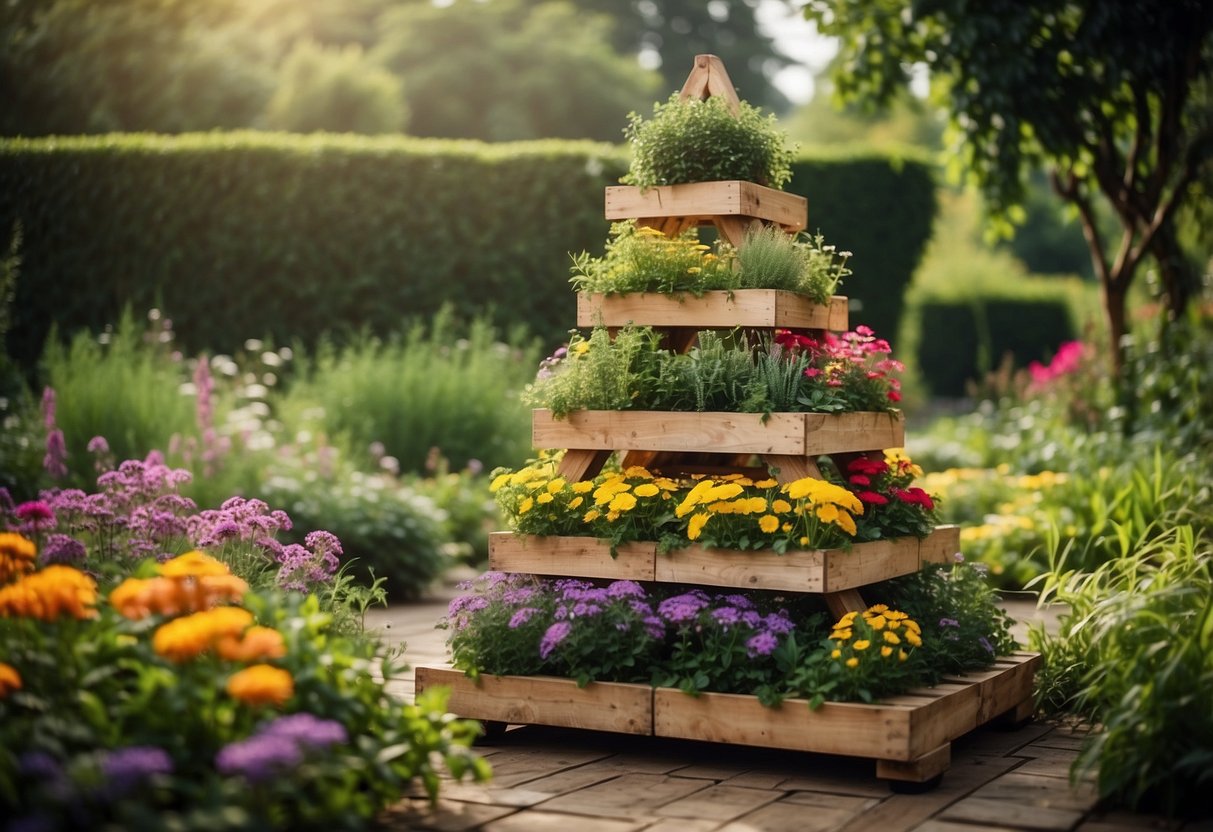
A Vertical Pallet Planter is perfect for small spaces. You can transform a simple pallet into a stylish and practical vertical garden.
Start by standing a pallet upright. Secure it in place to prevent tipping. Fill the spaces between the wooden slats with soil.
Plant your favorite herbs, flowers, or small vegetables. This planter allows you to make the most of limited garden areas.
Check out how to make a Vertical Pallet Planter with this handy guide.
9) Pyramid Trellis for Climbing Plants
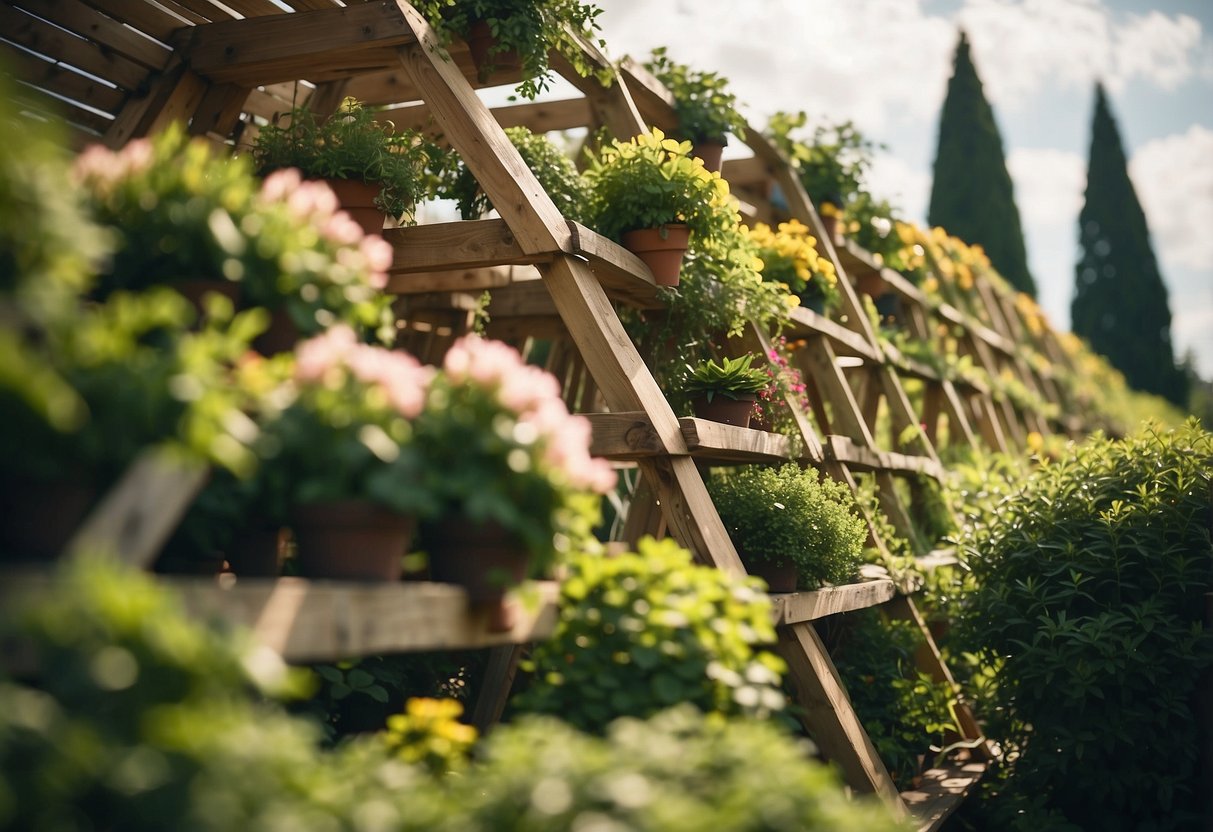
A pyramid trellis adds charm to your garden while giving plants the support they need.
You can use materials like wood, metal, or composite plastic. Wood is often preferred for its natural look. Start by laying the legs of the structure on a flat surface and securing them together with cross pieces.
Plant the climbing plants near the trellis and use garden twine to guide them upwards. This helps the plants grow strong and makes your garden look great. For more details, check out these step-by-step instructions.
10) Bird Bath Pyramid Garden
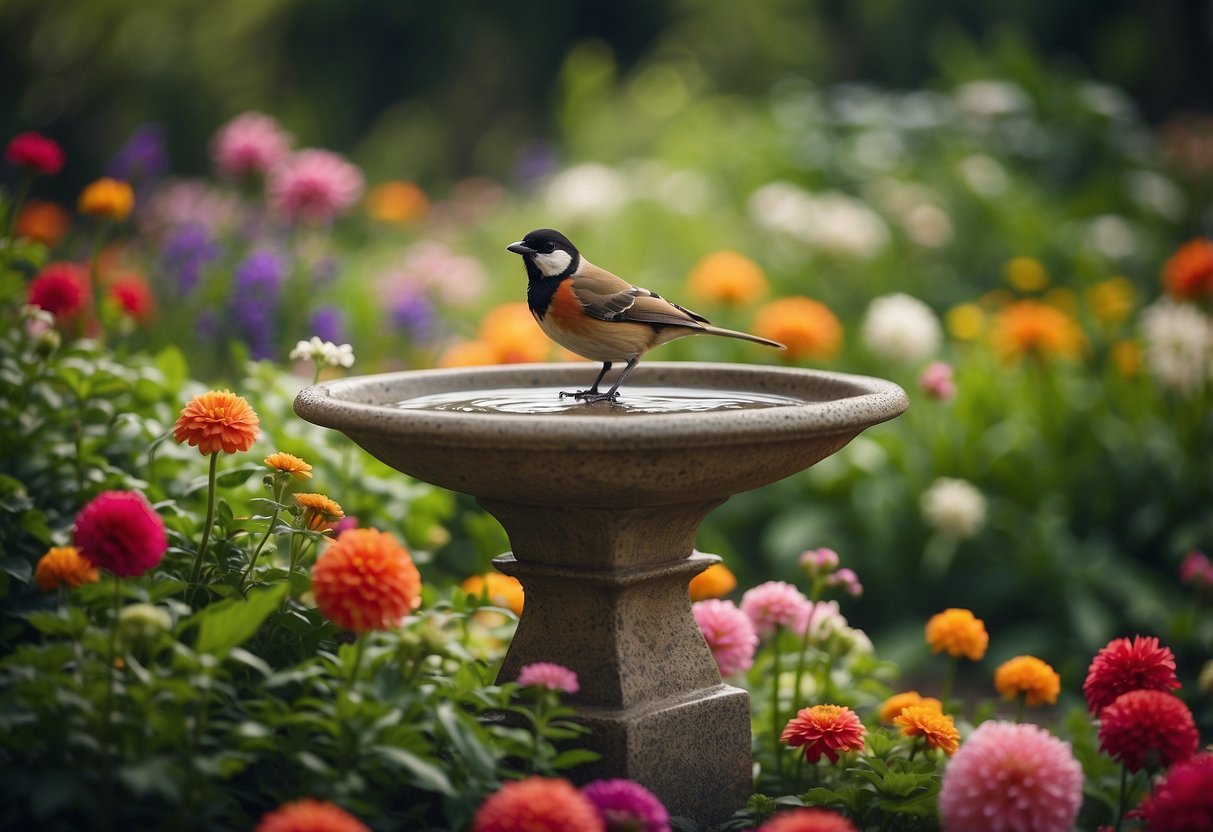
You can combine a bird bath with a pyramid design to create a unique and functional garden feature. Stack different sizes of planters or large stones to form a pyramid shape, placing a bird bath basin at the top.
Add flowers or succulents in the planter tiers for a pop of color. This setup will not only attract birds but also serve as an eye-catching garden centerpiece. For more inspiration, check out the Backyard Baron’s decorative bird bath ideas.
Use materials like terra cotta pots or fiber clay for a durable and attractive garden pyramid.
Benefits of Garden Pyramids

Garden pyramids offer several key benefits that make them an attractive choice for gardeners. They efficiently use space and enhance the beauty of any garden area.
Maximizing Space
One of the largest benefits of garden pyramids is space efficiency. These structures allow you to grow more plants in a smaller area compared to traditional garden beds. By stacking layers, you create multiple levels of growing space.
This is especially useful if you have a small garden or limited yard space. With a vertical garden like a pyramid, you can grow a variety of plants, including vegetables, herbs, and flowers, without needing a large plot of land. Each layer can hold different types of plants, maximizing the use of soil and sunlight.
A garden pyramid also helps in organizing your plants better. Each level can be dedicated to different plant types, making it easier to manage and care for them. If you want to save space and grow more plants, a garden pyramid is an excellent choice.
Enhanced Aesthetics
Garden pyramids are not just practical; they also improve the look of your garden. Their tiered design adds height and dimension, making your garden more visually appealing. This structure can become a focal point in your garden, drawing attention and adding interest.
You can customize your garden pyramid to match your taste and garden style. Different materials like wood, stone, or metal can be used to build the pyramid, giving you flexible design options. Planting a variety of colorful flowers and greenery on different tiers creates a vibrant and lush appearance.
Moreover, garden pyramids can be used to define garden areas or separate different sections. They provide a neat and organized look, helping your garden stand out. If you want to enhance the aesthetics of your outdoor space, adding a garden pyramid can make a significant difference.
Materials for Building Garden Pyramids
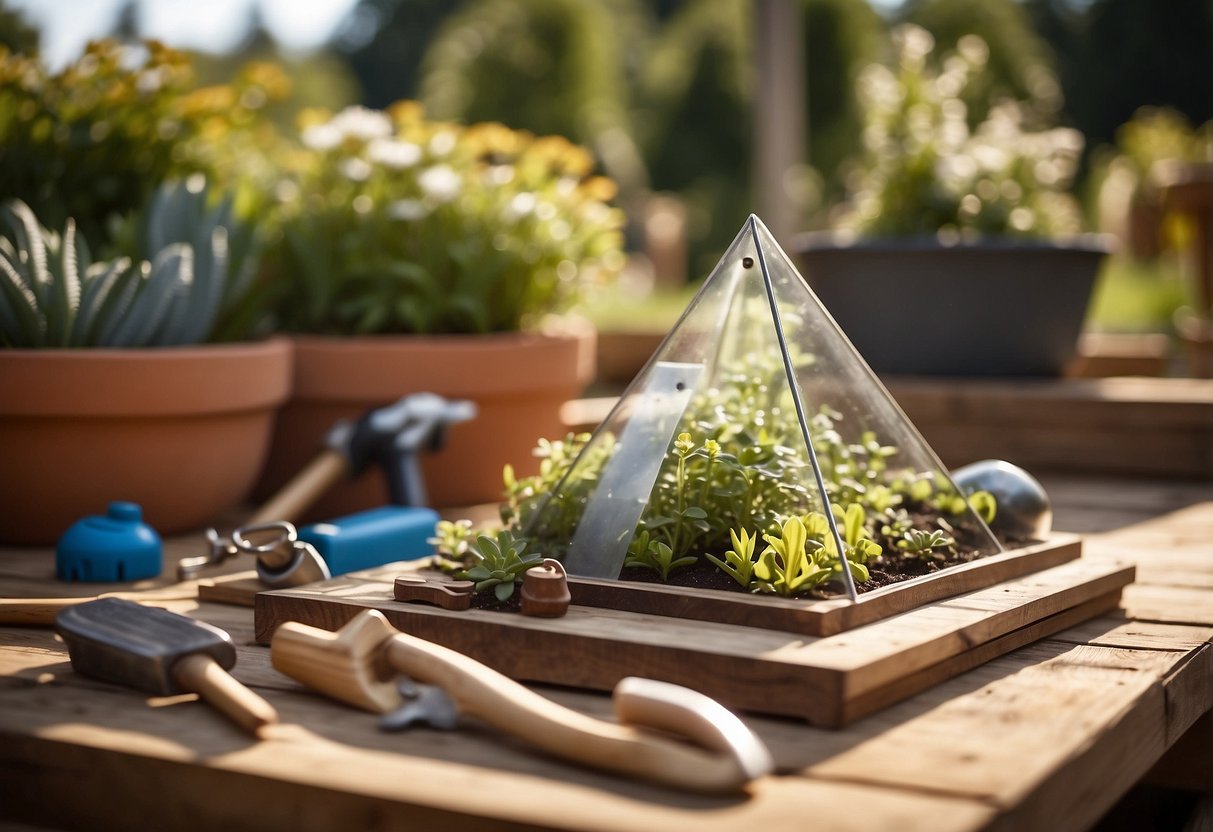
When building garden pyramids, the materials you choose can greatly affect their durability, appearance, and the types of plants you can grow. Common materials include wood, metal, and stone, each offering unique benefits.
Wood
Wood is a popular choice because it’s easy to work with and gives a natural, rustic look. Cedar and redwood are excellent options as they resist rot and weathering. Pressure-treated lumber can also be used but avoid those treated with harmful chemicals if you’re growing edibles.
Pros:
- Easy to cut and shape
- Readily available at hardware stores
- Offers a natural, classic look
Cons:
- May require maintenance or sealing
- Can be prone to pests if not treated properly
Wooden pyramid planters are ideal for growing strawberries, herbs, and small vegetables.
Metal
Metal garden pyramids are strong and durable, making them suitable for supporting climbing plants. Options range from steel to aluminum. Galvanized steel is rust-resistant and can withstand various weather conditions.
Pros:
- Extremely durable
- Supports heavy plants
- Low maintenance
Cons:
- Can be more expensive
- Harder to cut and assemble without proper tools
Metal pyramids are great for plants like tomatoes and cucumbers that need more structural support.
Stone and Other Natural Materials
Stone, brick, and other natural materials offer a robust and long-lasting option for garden pyramids. These materials create an elegant, timeless look but can be more challenging to build with due to their weight and the need for mortar or other binding agents.
Pros:
- Highly durable and weather-resistant
- Adds a sophisticated look to your garden
- Low maintenance once constructed
Cons:
- Heavy and difficult to move
- Requires more construction skills and tools
Stone or brick pyramids are well-suited for decorative plants and perennial herbs, providing a sturdy base that lasts for years.
Choosing the right material for your garden pyramid depends on your specific needs, whether it’s ease of construction, durability, or aesthetic appeal.
Maintenance Tips for Garden Pyramids
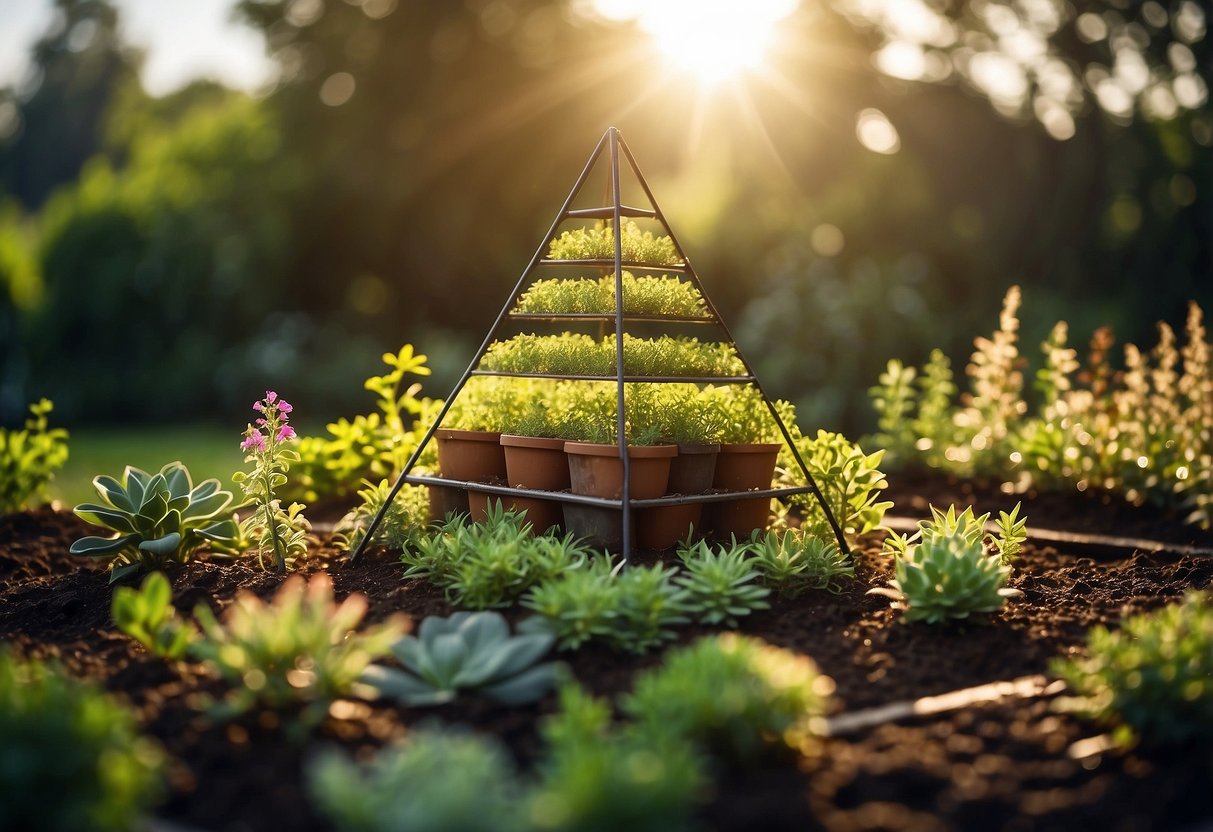
Keeping your garden pyramid in top shape is essential for plant health and growth. You’ll need to pay attention to seasonal care and pest management for the best results.
Seasonal Care
In spring, it’s time to prepare your pyramid for new plantings. Start by clearing away dead leaves and debris. Add compost or organic matter to the soil to boost its nutrients. This will give your plants a strong start.
Summer requires regular watering. Check the soil moisture at different levels of the pyramid, as the top soil may dry out faster than the bottom. Mulching can help retain moisture and keep roots cool.
Fall is for pruning and cleanup. Remove any dead or dying plants. This prevents disease and pests from overwintering in your pyramid. Add mulch or straw to protect the soil through the winter months.
Pest Management
Keep an eye out for common garden pests like aphids, slugs, and caterpillars. Regularly inspect your plants for signs of damage. Early detection makes control easier.
Use natural pest control methods whenever possible. Introduce beneficial insects like ladybugs and predatory nematodes. These can help keep harmful pests in check without chemicals.
For stubborn infestations, consider organic sprays. Neem oil or insecticidal soap can be effective. Always follow the instructions on any product you use to prevent harm to your plants.
Consistent monitoring and natural methods are key. They help maintain a healthy, thriving garden pyramid.







